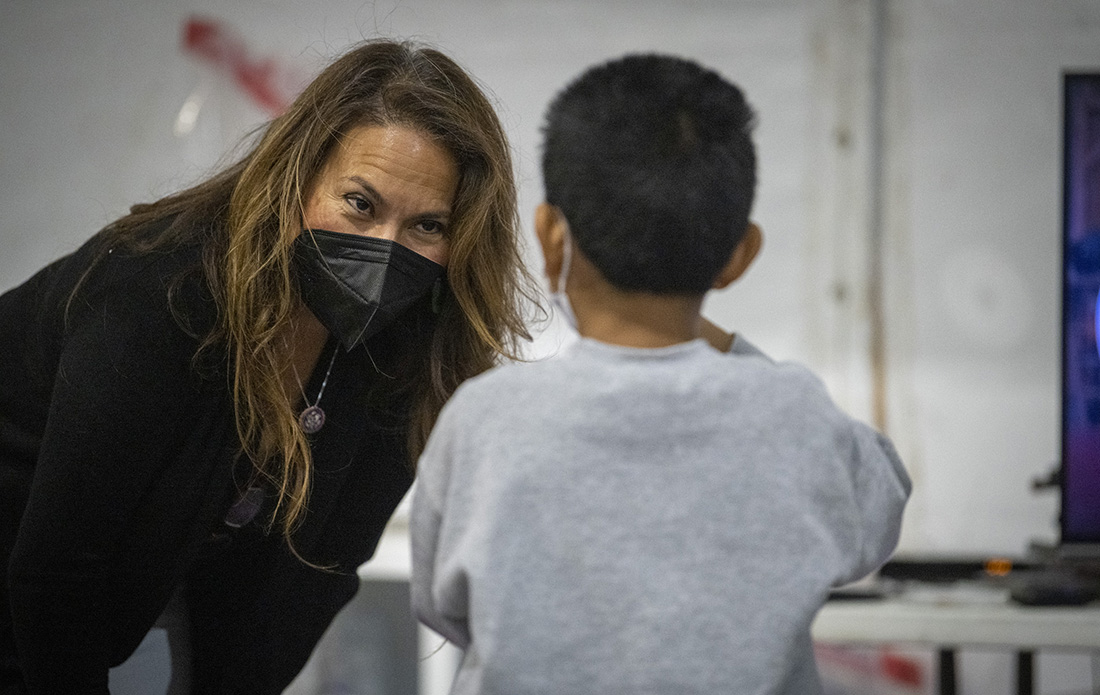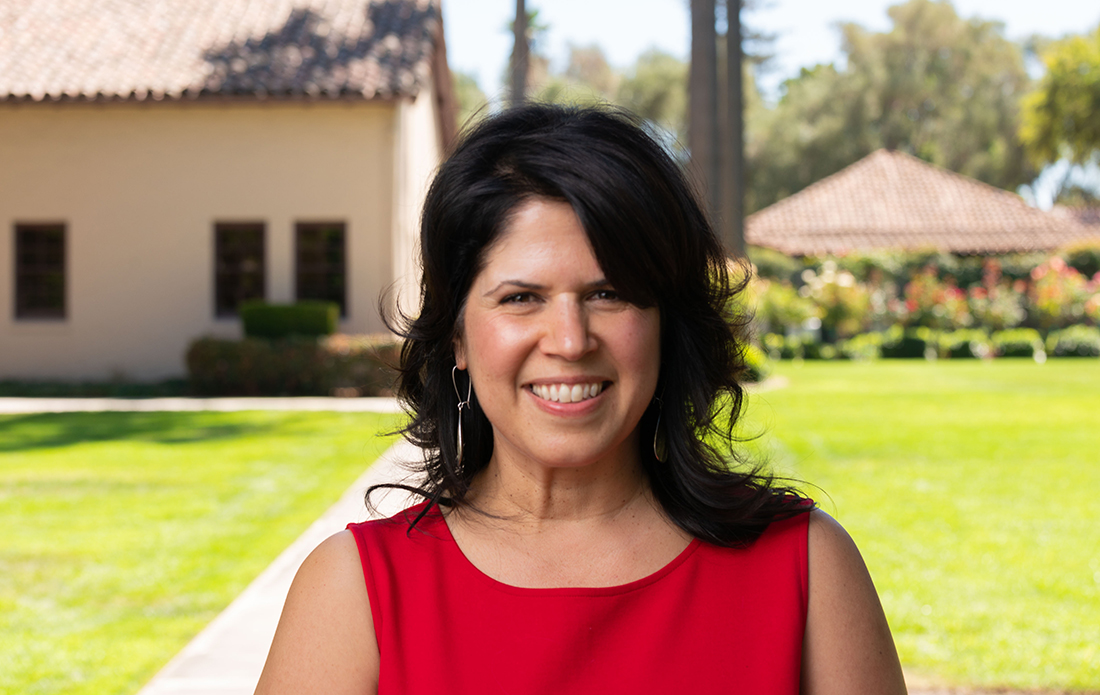‘Running Toward the Fire’

Professor Anna Sampaio makes no bones about the goal of her recent research: She wants more Latinas to run for national office because she wants equal representation and political parity in the highest elected offices.
Historically, Latinas have been woefully underrepresented in national politics. In 2022, they were more than 9% of the U.S. population, and 18% of all women, but just 2.8% of the U.S. congressional body. In fact, it wasn’t until 2016 that the first Latina was elected to the U.S. Senate when Catherine Cortez Masto won in Nevada.
Yet, even though record numbers of Latinas ran in 2018, 2020, and 2022, they continue to face uneven costs and obstacles that undermine their election prospects.
To better understand the challenges candidates faced, Sampaio and student research assistants Celeste Munoz ’22 and Renee Perry ’22 began studying Latina candidate emergence in the 2018 and 2020 elections. This included collecting data as well as conducting interviews with 24 Latina congressional members, candidates, and staffers. The work was funded by a grant from the Center for American Women and Politics as well as the Pivotal Ventures, founded by Melinda French Gates to accelerate social progress. They have shared the results of this work with academics, activists, and practitioners in the hopes of addressing the obstacles and building better support systems.
While Sampaio expected to hear about the systemic hurdles of party politics, funding issues, and even incidents of racism while collecting interviews, what she didn’t expect was an undercurrent of violent incidents targeting both congressional members and candidates.
“To be honest, it wasn’t what we set out to examine,” Sampaio says. “It just came up voluntarily and it kept coming up.”
In her interviews, Sampaio learned that the stoking of fires at the national level had trickled down into the daily lives of public-facing politicians in multiple forms including harassment, intimidation, physical violence, psychological abuse, and threats of harm to them, their property, and those close to them.
While the tenor of politics has gotten progressively more destructive, with politicians of different racial and ethnic groups encountering threats, Sampaio couldn’t help but wonder about the long-term impacts on this underrepresented population. Not only were these women often bigger targets due to the racialized political landscape and the progressive policies they advanced, but their seats at the table were already more tenuous to start with.

Professor Anna Sampaio
Political scientists often talk about the cost of participating in politics. Running for office comes with a variety of costs including time and money. For women of color, that cost is often higher. Since women of color have been historically excluded from electoral politics, simply getting the experience needed to be a viable candidate can be difficult. Once they run, says Sampaio, they often have less access to big-dollar donors and party support, which makes mounting a successful campaign even harder.
When you factor in the cost of threats of violence, the reality of running for office becomes even more daunting.
Sampaio wondered, in the face of this increased danger, if this record participation of Latinas in politics would continue in the long term.
“It was clear to me that the weight of these escalating attacks was landing on them differently than people like Eric Swalwell, Adam Kinzinger, or Liz Cheney who have openly shared death threats they have received,” Sampaio says.
“It takes a chunk out of you”
In her interviews, Sampaio found that the violence impacted candidates’ ability to run campaigns and even do the job once elected.
For example, multiple candidates reported reconsidering or scaling back on public events like fundraisers or hosting constituent meetings at a community center, dry cleaner, or grocery store. With increased risks of violence, those events might not be safe or would require additional security they couldn’t afford.
Some Latinas reported changing their daily routines to become less predictable in case someone followed them.
Democrat Marisa Calderon described an instance when an operative from an opposing candidate in her own party physically blocked her from filing ballot paperwork for a primary election. Her campaign manager intervened, but Calderon recalled feeling shaken and upset after the confrontation.
The mental health toll on the Latina candidates was also rampant. Candace Valenzuela lost a narrow race in Texas’s 24th Congressional district. Despite being what Sampaio describes as a “highly competitive candidate for the district” with moderate politics and a military background, she experienced racism and sexism during her campaign. Her opponent spoke not of policy but the “great replacement theory,” accusing her of trying to wipe out the white race.
Valenzuela told Sampaio she took solace knowing the majority of harassment came from people outside her district who wanted to silence her, but still, she admitted, “it takes a chunk out of you.”
For some, Jan. 6 was the culmination of the more anonymous incidents they faced in their districts. While many Americans were appalled by the insurrection, Sampaio says it acutely impacted many people of color because it was fueled by the racist and violent rhetoric of the preceding years.
U.S. Rep. Norma Torres, who was inside the U.S. Capitol on Jan. 6, 2021, spoke with Sampaio. As a child, Torres and her family came to the United States as refugees from Guatemala. Like many immigrants fleeing authoritarian violence in their home country, her parents withstood perilous conditions during the journey in hopes of providing a better life for their children in the U.S.
That day, after fleeing the house floor, Torres found herself pacing her ransacked office wielding a baseball bat, ready to protect herself from the exact type of violence her family escaped from in Guatemala. After a few moments, she dropped the bat and burst into tears.
“Then the expectation is Torres is somehow going to buck up and get back to work as if nothing happened,” Sampaio says. “That‘s a nice sentiment, and I can appreciate it at some level, but it really belies all of these compounding forms of violence they come to office with.”
Solutions from within
The cost proved too much for some. Several candidates Sampaio and her students interviewed left the political sphere, noting the risks to safety and heavy emotional strain weren’t worth it.
Those who remained echoed a common call to action: if they weren’t there to move their agenda forward, who would? On both sides of the aisle, legislation concerning immigration and reproductive rights served as a mobilizing factor for them.
“If Sen. Cortez Masto in Nevada chooses not to run for re-election,” Sampaio says, “there would be no Latina carrying the issue of immigration in the body of the Senate.”
Rep. Veronica Escobar of El Paso described the experience as “running toward the fire.” When Sampaio talked to Escobar, her constituents had consistently faced targeted attacks from the Trump administration concerning immigration. She felt a sense of duty to battle for her constituents, especially in the aftermath of a 2019 racially motivated mass shooting at a Walmart in El Paso that killed 23 people.
In the face of these disturbing realities, how can Latina candidates be better supported? Sampaio is on it. She's already published two articles about her research, with more on the way. She also has participated in two events hosted by the Center for American Women and Politics to discuss her findings.
But some of the best answers, she and her research team say, came from the women themselves.
“One of the patterns we saw was the different ways these candidates created methods of support and non-traditional ways to get to where they are today,” Renee Perry says.
Valenzuela’s campaign, in particular, was a shining example. When the Texan didn’t receive the support she needed from the traditional political machines, she built an informal network of Latina candidates to find solutions.
One of their most impactful revelations regarded childcare. Like many political candidates, Valenzuela had to pay for childcare so she could run her campaign, and she found that the costs of childcare skyrocketed during the pandemic as daycare centers and schools closed. Her only option was private child care, which she could not afford. Valenzuela found support from a group of other women who discovered how to use campaign finances to cover the costs. Word spread among other candidates and suddenly a huge obstacle to their candidacy was cleared.
Valenzuela also took the compounding stress of the current political climate seriously. Win or lose, she set aside money for therapy for herself and her staff. Sampaio says the idea of resilience and pulling yourself up by your bootstraps assumes we all have the same emotional buffers, support networks, and financial resources to fall back on.
“The truth is, that’s not the case,” Sampaio says. “Access to the financial and emotional buffers is conditioned on factors such as race, gender, and income and women of color often do not have the same access.”
And if people don’t invest the time and resources to repair the stress and strain after a campaign, she says, it gets worse and worse.
The challenge now is to fund these solutions and amplify them. Sampaio plans to do her part. Her work with the Center for American Women and Politics will continue and her conversations with these political candidates will stay with her.
“These words are precious. What they were willing to share with me is so important and pressing,” Sampaio says. “I feel this incredible duty to do justice to what they’ve shared.”
Seeking answers to the most timely and important social justice issues, ethnic studies empowers every student with a vital understanding of their changing world.